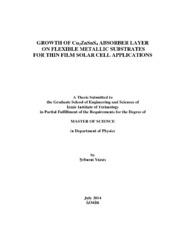Please use this identifier to cite or link to this item:
https://hdl.handle.net/11147/4246| Title: | Growth of Cu2znsns4 Absorber Layer on Flexible Metallic Substrates for Thin Film Solar Cell Applications | Other Titles: | İnce Film Güneş Pili için Cu2znsns4 Soğurucu Katmanının Esnek Metalik Alttaşlar Üzerinde Büyütülmesi | Authors: | Yazıcı, Şebnem | Advisors: | Aygün Özyüzer, Gülnur | Keywords: | Thin film solar cells Cu2ZnSnS4 |
Publisher: | Izmir Institute of Technology | Abstract: | This thesis presents the results of the fabrication and investigation of Cu2ZnSnS4 (CZTS) p-type semiconducting compound on rigid and flexible substrates, such as soda lime glass, ceramics and metallic foil substrates. The CZTS material was obtained by using a two-stage method. In the first stage, the metallic precursor was deposited by using DC magnetron sputtering technique then, the sulfurization process followed it. The particular emphasis has been placed on the distinctive substrate behavior in the growth procedure, including the microstructural characterization of the CZTS structure and the investigations of the back contact/CZTS interface. Additionally, the effect of the high temperature sulfur treatment on the formation mechanism of CZTS structure inves-tigated elaborately. Moreover, electrical properties including the temperature dependent electrical conductivity, carrier concentrations and mobility extracted from Hall Effect measurements, and optical properties including absorption coefficient, spectral transmis-sion, and optical band gap have been determined to characterize CZTS thin films. Raman spectroscopy and XPS analysis of the sulfurized thin films revealed that, except for the presence of Sn-based secondary phases, nearly pure CZTS thin films were obtained. Additionally, the intense and sharp XRD diffraction peak from the (112) plane provided evidence of good crystallinity. EDS analysis indicated sufficient sulfur content but poor Zn atomic weight percentage in the films. Absorption and band-gap energy analysis were carried out to confirm the suitability of CZTS thin films for the usage as the absorber layer in solar cell applications. Finally, Hall Effect measurements showed the p-type semiconductor behavior of the CZTS samples. We aimed to investi-gate the role of the flexible titanium and molybdenum foil substrates in the growth mechanism of CZTS thin films. The crack formation in the CZTS layer on the Mo foils were detected, which is an indication of the incompatible thermal expansion coefficient of Mo with the CZTS structure. | Description: | Thesis (Master)--Izmir Institute of Technology, Physics, Izmir, 2014 Includes bibliographical references (leaves: 82-87) Text in English; Abstract: Turkish and English Full text release delayed at author's request until 2017.08.13 |
URI: | http://hdl.handle.net/11147/4246 |
| Appears in Collections: | Master Degree / Yüksek Lisans Tezleri |
Files in This Item:
| File | Description | Size | Format | |
|---|---|---|---|---|
| 10018631.pdf | MasterThesis | 4.35 MB | Adobe PDF |  View/Open |
CORE Recommender
Page view(s)
304
checked on Mar 10, 2025
Download(s)
284
checked on Mar 10, 2025
Google ScholarTM
Check
Items in GCRIS Repository are protected by copyright, with all rights reserved, unless otherwise indicated.